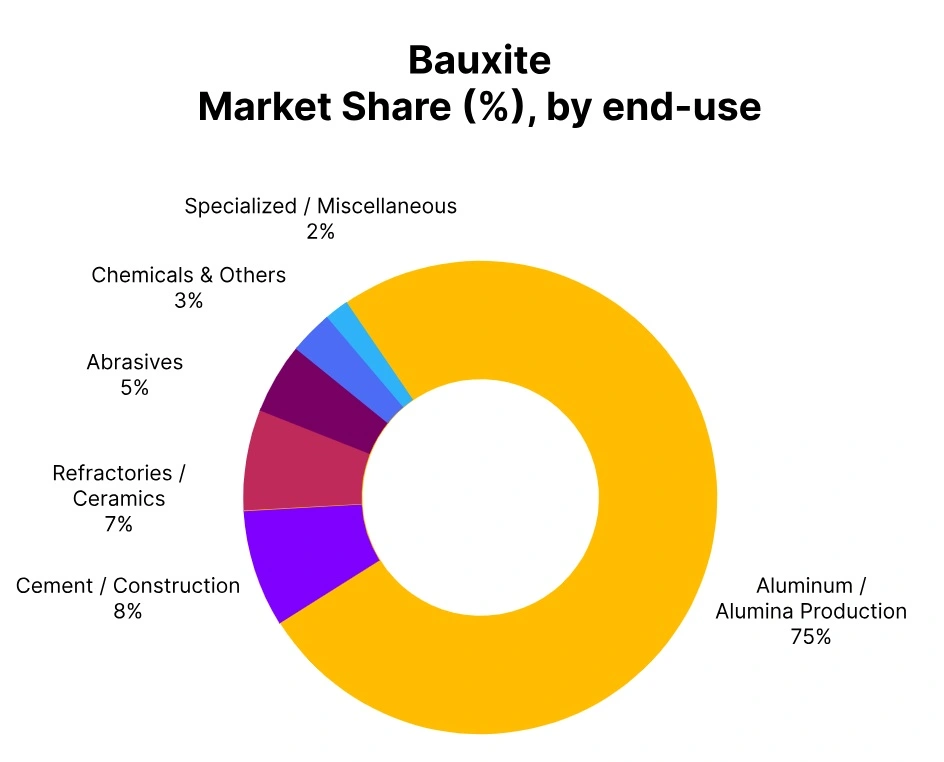Price-Watch’s most active coverage of Bauxite price assessment:
- Non Calcined (45% Min.) FOB Kamsar, Guinea
- Non Calcined (45% Min.) CIF Qingdao (Guinea), China
- Non Calcined (45% Min.) CIF Mundra (Guinea), India
- Non Calcined (45% Min.) FOB Brisbane, Australia
Bauxite
In Q3 2025, the global bauxite market experienced a notable price correction, with average prices declining by approximately 17–20% compared to Q2 2025. This downward trend was mainly driven by lessened demand from major alumina refineries amid slower-than-expected growth in the aluminium sector, particularly in China and Southeast Asia.
Additionally, increased supply from Guinea and Australia contributed to oversupply pressures. Operational expansions and improved logistics in West Africa enabled higher export volumes, further weighing global prices. Currency fluctuations and lower energy costs also reduced production expenses, influencing spot market pricing.
Guinea
The bauxite price trend in Guinea during Q3 2025 reflected a sharp correction, with prices falling by approximately 19% compared to Q2 2025. This decline was primarily attributed to a surplus in export volumes as mining activities in the Boké and Kindia regions operated at near maxiumum capacity. Less demand from Chinese and Indian alumina refinery, combined with high stockpiles at ports, further pressured prices downward.
However, bauxite prices saw a modest rebound in September 2025, increasing by around 2% month-on-month, supported by slight restocking activity and improved freight movement following seasonal disruptions. Market participants noted temporary supply constraints due to stricter port inspections and new environmental checks. Despite the quarterly drop, the marginal September recovery signaled potential price stabilization ahead.
China
According to PriceWatch, the bauxite price trend in China during Q3 2025 showed a significant decline, with prices dropping by approximately 19% compared to Q2 2025. This downward movement was largely driven by subdued demand from domestic alumina refineries, which operated at reduced capacity due to oversupply and weak aluminium margins.
Furthermore, a steady inflow of imported bauxite from Guinea and Indonesia led to increased stock levels at major ports like Lianyungang and Fengcheng, adding further pressure on domestic prices. Soft macroeconomic indicators and cautious infrastructure spending also weighed overall consumption.
Bauxite prices saw a slight recovery in September 2025, rising by 1% month-on-month, as some refineries resumed operations in anticipation of seasonal demand in Q4. The slight rebound was also supported by a slowdown in import volumes and improved sentiment across the non-ferrous metals sector.
India
According to PriceWatch, the price trend of bauxite in India during Q3 2025 witnessed a notable decline, with prices falling by approximately 14% compared to Q2 2025. This decrease was primarily driven by a slowdown in procurement from domestic alumina producers, particularly in Odisha and Gujarat, amid reduced production rates and high inventory levels.
The oversupply was further intensified by consistent mining output from major public and private sector players, including NALCO and Hindalco, without a corresponding rise in downstream demand. Additionally, limited export activity and subdued demand from the construction and automotive sectors contributed to bearish market sentiment.
However, bauxite prices experienced a marginal increase of 1% in September 2025, supported by early signs of recovery in alumina plant operations and increased logistical activity ahead of the festive season.
Australia
The bauxite price trend in Australia during Q3 2025 witnessed a significant decline, with prices decreasing by approximately 18% compared to Q2 2025. This downturn was primarily driven by softened global demand, particularly from Chinese alumina refineries operating at reduced capacity due to environmental regulations and oversupply concerns. Additionally, higher freight costs and a strong Australian dollar further pressured export competitiveness.
Weaker construction and manufacturing activity worldwide also contributed to lower bauxite consumption, impacting Australian exports. However, Bauxite prices showed a slight recovery in September 2025, rising by 2% amid signs of restocking demand and marginal improvements in downstream alumina and aluminium markets. Supply disruptions in other regions and anticipation of infrastructure spending in Asia provided temporary support to market sentiment.



